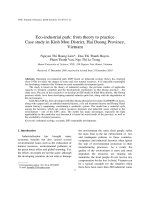computer viruses - from theory to applications
Bạn đang xem bản rút gọn của tài liệu. Xem và tải ngay bản đầy đủ của tài liệu tại đây (2.66 MB, 411 trang )
Computer viruses:
from theory to applications
Springer
Paris
Berlin
Heidelberg
New York
Hong Kong
Londres
Milan
Tokyo
Eric Filiol
Computer viruses:
from theory to applications
3
Eric Filiol
Chef du laboratoire de virologie et cryptologie
École Supérieure et d'Application des Transmissions
B.P. 18
35998 Rennes Armées
et INRIA-Projet Codes
ISBN 10: 2-287-23939-1 Springer Berlin Heidelberg New York
ISBN 13: 978-2-287-23939-7 Springer Berlin Heidelberg New York
© Springer-Verlag France 2005
Printed in France
Springer-Verlag France is a member of the group Springer Science + Business Media
First edition in French © Springer-Verlag France 2004
ISBN : 2-287-20297-8
Apart from any fair dealing for the purposes of the research or private study, or criticism or review, as permitted under
the Copyright, Designs and Patents Act 1998, this publication may only be reproduced, stored or transmitted, in any
form or by any means, with the prior permission in writing of the publishers, or in the case of reprographic reproduc-
tion in accordance with the terms of licenses issued by the copyright. Enquiry concerning reproduction outside those
terms should be sent to the publishers.
The use of registered names, trademarks, etc, in this publication does not imply, even in the absence of a specific sta-
tement, that such names are exempt from the relevant laws and regulations and therefore free for general use
SPIN: 11361145
Cover design : Jean-François MONTMARCHÉ
To my wife Laurence,
to my son Pierre,
to my parents,
to Fred Cohen,
to Mark Allen Ludwig
Preface
“Viruses don’t harm, ignorance does. Is ignorance a defense?”
herm1t
“[ ] I am convinced that computer viruses are not evil and that
programmers have a right to create them, to possess them and to
experiment with them . . . truth seekers and wise men have been per-
secuted by powerful idiots in every age . . .
´
’
Mark A. Ludwig
Everyone has the right to freedom of opinion and expression; this
right includes freedom to hold opinions without interference and to
seek, receive and impart information and ideas through any media
and regardless of frontiers.
Article 19 of Universal Declaration of Human Rights
The purpose of this book is to propose a teaching approach to under-
stand what computer viruses
1
really are and how they work. To do this,
three aspects are covered ranging from theoretical fundamentals, to prac-
tical applications and technical features; fully detailed, commented source
1
We will systematically use the plural form “viruses” instead of the litteral one “virii”.
The latter is now an obsolete, though gramatically recommended, form.
VIII Preface
codes of viruses as well as inherent applications are proposed. So far, the
applications-oriented aspects have hardly ever been addressed through the
scarce existing literature devoted to computer viruses.
The obvious question that may come to the reader’s mind is: why did the
author write on a topic which is likely to offend some people? The motivation
is definitely not provocation; the original reason for writing this book comes
from the following facts. For roughly a decade, it turns out that antiviral
defense finds it more and more difficult to organize and quickly respond
to viral attacks which took place during the last four years (remember the
programs caused by the release of worms, such as Sapphire, Blaster or Sobig,
for example). There is a growing feeling among users – and not to say among
the general public – that worldwide attacks give antivirus developers too
short a notice. Current viruses are capable of spreading substantially faster
than antivirus companies can respond.
As a consequence, we can no longer afford to rely solely on antivirus
programs to protect against viruses and the knowledge in the virus field is
wholly in the hands of the antiviral community which is totally reluctant
to share it. Moreover, the problems associated with antiviral defense are
complex by nature, and technical books dedicated to viruses are scarce,
which does not make the job easy for people interested in this ever changing
field.
For all of these reasons, I think there is a clear need for a technical book
giving the reader knowledge of this subject. I hope that this book will go
some way to satisfying that need.
This book is mainly written for computer professionals (systems adminis-
trators, computer scientists, computer security experts) or people interested
in the virus field who wish to acquire a clear and independent knowledge
about viruses as well as incidently of the risks and possibilities they repre-
sent. The only audience the book is not for, is computer criminals, unfairly
referred as “computer geniuses” in the media who unscrupulously encourage
and glamorize them somehow. Computer criminals have no other ambition
than to cause as much damage as possible, which mostly is highly prejudi-
cial to everyone’s interests. In this situation, it is constructive to give some
essential keys that open the door to the virus world and to show how wrong
and dangerous it is to consider computer criminals as “geniuses”.
With a few exceptions, the vast majority of computer vandals and com-
puter copycats simply copy existing programs written by others and clearly
are not very well versed in computer virology. Their ignorance and silliness
just casts a shadow over a fascinating and worthwhile field. As said the fa-
Preface IX
mous French writer, F. Rabelais in 1572, “science without conscience is the
soul’s perdition”.
The problem lies in the fact that users (including administrators) are
doomed, on the one part, to rely on antivirus software developed by profes-
sionals and, on the other part, to be subjected to viral programs written by
computer criminals. Computers were originally created to free all mankind.
The reality is quite different. There is no conceivable reason why some self-
proclaimed experts driven for commercial interests should restrict computer
knowledge. The latter should not be the exclusive domain of the antiviral
programs developers.
In this respect, one of the objectives of the book is to introduce the reader
to the basic techniques used in viral programs. Computer virology is indeed
simply a branch of artificial intelligence, itself a part of both mathematics
and computer science. Viruses are only simple programs, which incidentally
include specific features.
However uncomfortable that may be for certain people, it is easy to pre-
dict that viruses will play an important role in the future. The point of this
book is to provide enough knowledge on viruses so that the user becomes
self-sufficient especially when it comes to antiviral protection and can find
a suitable solution whenever his antiviral software fail to eradicate a virus.
Whether one likes it or not, computer virology teaching is gradually becom-
ing organized. At Calgary University, Canada, computer science students
have been offered a course in virus writing since 2003, which as might be
expected, has set off a wave of criticism within the antivirus community (the
reader will refer to [138,139,147–149] for details).
For all of the above-mentioned reasons, there is no option but to work
on raw material: source codes of viral programs. Knowledge can only gained
through code analysis. Here lies the difference between talking about viruses
and exploring them. Studying viruses surely will not make you a computer
vandal for all that, on the contrary. Every year, thousands of people are
studying chemistry. As far as I know, they rarely indulge in making chem-
ical weapons once they have received their Ph. D degree. Should we ban
chemistry courses to avoid potential but unlikely risks even though they do
exist and must be properly assessed? Would it not be a nonsense to give up
the benefits chemistry brings to mankind? The same point can be made for
computer virology.
There is another reason for speaking in favour of a technical analysis of
viruses. Unexpectedly, most of the antivirus publishers, are partly responsi-
ble for viruses. Because some of them chose a commercial policy enhanced
XPreface
by a fallacious marketing, because some of them are reluctant to disseminate
all relevant technical information, users are inclined to think that antivirus
software is a perfect protection, and that the only thing to do is to buy any-
one of them to get rid of a virus. Unfortunately, the reality is quite different
since most antiviral products have proved to be unreliable. In practice, it is
not a good thing to rely solely on commercial anti-virus programs for pro-
tection. It is essential that users get involved in viral defense so that they
may assess their needs as far as protection is concerned, and thus choose
appropriate solutions. This presupposes however, some adequate knowledge
as basic background.
The last reason for providing a clear presention of the viral source code,
is that it will enable to both explain and prove what is possible or not in
this field. Too many decision-makers tend to base their antiviral protection
policies on hazy and ill-defined concepts (not to say, fancy concepts). Only a
detailed analysis of the source codes will provide a clear view of the problems
thus easing the decision maker’s task.
In order that the book may be accessible to nonspecialists, prerequisite
knowledge for a good understanding of the described concepts are kept to
a minimum. The reader is assumed to have a good background in basic
mathematics, in programming, as well as basic fundamentals in operating
systems such as Linux and Unix. Our main purpose is to lay a heavy em-
phasis on what could be called “viral algorithmics” and to show that viral
techniques can be simply explained independently from either any language
or operating system.
For simplicity’s sake, the C programming language and pseudo code have
been used whenever it was pertinent and possible, mainly because most
computer professionnals are familiar with this language. In the same way,
I have chosen simple examples, and have geared the introduction toward
nonspecialists.
Some readers may regret that many aspects of computer virology have not
been deeply covered, like mutation engines, polymorphism, and advanced
stealth techniques. Others may object that no part of the book is devoted
to viruses or worms written in assembly language or in more “exotic” yet
important languages like Java, script languages like VBS or Javascript, Perl,
Postscript Recall once again that, the book’s purpose is a general and ped-
agogical introduction based on simple and illustrative examples accessible,
to the vast majority of people. It is essential to understand algorithmics
fundamentals shared by both viruses and worms, before focusing on specific
features inherent to such or such language, technique, or operating system.
Preface XI
Complex and sophisticated aspects related to computer virology will be ex-
plored in a subsequent book.
Other readers also may regret that antiviral methods are not fully covered
in the book, and consequently may think that antiviral aspects are pushed
into the background. Actually, there is a reason behind this. When consid-
ering security issues in general, detection, defense and prevention measures
can be taken because we anticipate what kind of attacks might be launched.
As far as viruses are concerned, it is the other way round any defense and
protection measure will be illusory and ineffective as long as viral mecha-
nisms are not analysed and known.
The book consists of three relatively independent parts and can be read
in almost any order. However, the reader is strongly advised to read Chap-
ter 2 first. It describes a taxonomy, basic tools and techniques in computer
virology so that the reader may become familiar with the terminology inher-
ent to viral programs. This basic knowledge will be helpful to understand
the remaining portions of the book.
The first part of the book deals with theoretical aspects of viruses. Chap-
ter 2 sums up major works which laid the foundations of computer virology
namely, Von Neuman’works on self-reproducing automata, Kleene’s works
on recursive functions as well as Turing’s works. These mathematical bases
are essential to understand the rest of the book. Chapter 3 focuses on Fred
Cohen’s and Leonard Adleman’s formalisations. These works enable one to
provide an overview of both viral programs and antiviral protection. Skip-
ping this chapter would prevent the reader from understanding some impor-
tant aspects and issues related to computer virology.
Chapter 4 provides an exhaustive classification of computer infections
while presenting the main techniques and tools as well. It includes essential
definitions which will prove to be extremely helpful as background for the
subsequent chapters. Although the reader is urged to read this chapter first
and foremost, it has been included at this place in the book to follow the
logical pace of the book, and the chronology of historical events in the field.
This first part is suitable for a six hours theoretical course on this topic.
The material is intended for use by readers who are not familiar with math-
ematics: the concepts have been simplified whenever possible, as much as
required while avoiding any loss of mathematical rigor.
The second part is more technical and explores the source codes of some
of the most typical viruses belonging to the main families. Here again, it
is intended for nonspecialists and no prerequisites are needed except skills
in programming. Only very simple but real life viruses which may be still a
XII Preface
threat at present time, are studied. Fascinating but sophisticated techniques
like polymorphism or stealth will not be deeply explored in this first volume
since they require good skills in assembly language. Nevertheless, the ma-
teriel in this part will help the readers become familiar with source codes so
that they may be able to analyse most other existing viruses on their own.
Doing so, the reader can find out what he can and cannot expect from any
antivirus program.
The third part may be the most important one. It is dedicated to the
application-oriented aspects of the viruses. Viral programs are extremely
powerful tools and may be applied to many areas. Among the rare technical
books dedicated to viruses, none of them really treat this aspect. The idea
that a virus may be “useful” or “benevolent” has sparked a minor revolution
among the antiviral programs developers who maintain a fierce opposition
to it. Anyway, this narrow-minded attitude is illusive and sterile, while mo-
tivated by a variety of interests, very likely.
It must be stressed that viruses have been applied successfully to a wide
range of areas for a long time, even if it has not been made public. When
properly controlled, viruses are bound to provide benefits (in this respect,
antiviral programs could have a new role to play in order to make them
evolve in an adequate way). The point of this part is to make people aware
of this perspective.
The dependence relation of the parts of the book is as follows:
P1c1 P1c2
P1c3P1c4
Part 1
Part 2 Part 3
This book is partly derived from courses in computer virology (whose
lengths range from 15 to 35 hours including practicals) which have been given
at various French universities and engineering colleges (both at a graduate
level):
´
Ecole Sup´erieure d’
´
Electricit´e since 2002,
´
Ecole Nationale Sup´erieure
des Techniques Avanc´ees since 2001, Saint-Cyr military academy since 1999,
university of Limoges since 2001, university of Caen since 2003 I hope this
book will be a helpful, comfortable and resourceful tool for any instructor
wishing to build and teach such a module. I think, there are many ways in
which the book can be used in teaching a course.
Preface XIII
Each chapter ends with some exercises. Most of them offer the opportu-
nity to work with concepts and material that have just been introduced in
the chapter, in order to become familiar with them. Understanding will be
greatly enhanced by doing the exercises. In some cases, projects are also pro-
posed (from two to eight weeks). I hope that this book will help instructors
to find creative ways of involving students in this exciting field.
Be warned, although this book is designed for an English-speaking public,
some of the bibliography references given at the end of this book refer to their
original version when of outstanding quality while no English translation
exists. I am also acutely aware that typographical mistakes, and errors may
still be found in this text. The reader is encouraged to contact me with his
corrections, comments, suggestions so that the book may be improved in
subsequent printings. Errors will be corrected on my webpage (www-rocq.
inria.fr/codes/Eric.Filiol/index.html) on which hints or solution to
exercises, along with other information are available.
This book is dedicated to one of the founding fathers in the field, Dr.
Frederick B. Cohen. Without his pioneering work, computer virology would
still be only in its infancy. His work on formalisation and his results un-
fortunately have not aroused the interest it deserved. His contribution is
nevertheless of outstanding importance and the reader is urged to refer to
his works on many occasions through this book.
This book is also dedicated to Mark Allen Ludwig who has blazed the trail
in this area, publishing some technical books on viruses including a number
of detailed source codes. His educational, thoughtful, insightful approach is
remarkable. Considering the author’s considerable achievements in this field
as well as his scientific rigor (so far he has authored four books on computer
viruses and evolution), he can be considered as a guide for anyone fond of
computer viruses and artificial intelligence.
At last, I would also like to dedicate this book to some intelligent, curious
and talented virus programmers, mostly anonymous, who also contributed
to develop this area and from whom we learned much of what we know
today; these people are driven by technical challenges rather than destructive
desires. The code of some of their viruses is remarkable and has greatly
stimulated my interest in this field. They convinced me, for example, that in
the computer virology area, as in many other scientific disciplines, humility
is the main required quality. Finally, I hope that some of my passion for
viruses has worked its way into these pages.
This book would not have been written without the support and help
of many people. It is impossible however, to list all people who contributed
XIV Preface
along the way. I am acutely aware that someone else’s name should probably
also be mentionned and I apologise to them. I would like to thank the staff at
Springer Verlag publishing in Paris who have been courteous, competent and
helpful especially Mrs. Huilleret and Mr. Puech for their continued support
and enthusiasm for this project.
I am also grateful to the 2nd Lieutenants Azatazou, De Gouvion de Saint-
Cyr, H´elo, Plan, Smithsombon, Tanakwang, Ratier and Turcat, who were
involved in the development of some variants of viruses during their M.Sc.
internship in the laboratory of virology and cryptology at the French Army
Signals Academy. I would also like to express my gratitude for the support
of Major General Bagaria, Colonel Albert (from French Marines Corps!),
Lieutenant-Colonel Gardin and Lieutenant-Colonel Rossa, who realized that
computer virology is bound to play an outstanding part in the future and
that it is essential to provide technical knowledge to Defense specialists.
I am also indebted to Christophe Bidan, Nicolas Brulez, Jean-Luc Casey,
Thi´ebaut Devergranne, Major Alain Foucal, Brigitte J¨ulg, Pierre Loidreau,
Marc Maiffret, Thierry Martineau, Captain Mayoura, Arnaud Metzler,
Bruno Petazzoni, Fred´eric Raynal, Marc Rybowicz, Eug`ene H. Spafford,
Denis Tatania and Alain Valet, who enabled me to share my passion and to
all my students whose interest and enthusiastic responses encouraged me to
write the book. The interplay between research and teaching was a delightful
experience.
I would like to thank my wife Laurence who helped me to translate the
first edition into English and the native speakers who made the proofreading
of the manuscript and worked hard to correct the errors and clumsiness of
this version: especially Mr and Mrs Camus-Smith whose work has been
invaluable.
Finally, I would like to express my gratitude for the support of my family,
especially my wife without which this work would not have been possible.
She designed the cdrom provided with this handbook as well.
Let us now explore the fascinating world of computer viruses.
Guer, August 2003,
´
Eric Filiol
Contents
Foreword VII
Part I - Genesis and Theory of Computer Viruses
1 Introduction 3
2 The Formalization Foundations 7
2.1 Introduction 7
2.2 TuringMachines 8
2.2.1 Turing Machines and Recursive Functions . . . . . . . . . . . 9
2.2.2 UniversalTuringMachine 13
2.2.3 The Halting Problem and Decidability . . . . . . . . . . . . . . 15
2.2.4 RecursiveFunctionsand Viruses 17
2.3 Self-reproducingAutomata 19
2.3.1 The Mathematical Model of Von Neumann Automata . 20
2.3.2 Von Neumann’s Self-reproducing Automaton . . . . . . . . . 28
2.3.3 The Langton’sSelf-reproducingLoop 31
Exercises 34
StudyProjects 36
Studyof theHerman’sTheorem 36
CoddAutomataImplementation 37
3 F. Cohen and L. Adleman’s Formalization 39
3.1 Introduction 39
3.2 FredCohen’s Formalization 41
3.2.1 Basic ConceptsandNotations 42
3.2.2 FormalDefinitionofViruses 44
XVI Contents
3.2.3 Study and Basic Properties of Viral Sets . . . . . . . . . . . . . 47
3.2.4 Computability Aspects of Viruses and Viral Detection . 51
3.2.5 Prevention andProtection Models 55
3.2.6 Experiments with Computer Viruses and Results . . . . . 61
3.3 LeonardAdleman’sFormalization 65
3.3.1 Notation and Basic Definitions 66
3.3.2 TypesofVirusesandMalware 70
3.3.3 TheComplexityofViral Detection 72
3.3.4 StudyingtheIsolation Model 75
3.4 Conclusion 77
Exercises 78
StudyProjects 80
Implementation of the Theorem8Machine 80
Implementation of Machine Described in Theorem 11 . . . . . . . 80
4 Taxonomy, Techniques and Tools 81
4.1 Introduction 81
4.2 General Aspects of Computer Infection Programs . . . . . . . . . . 83
4.2.1 DefinitionsandBasicConcepts 83
4.2.2 Action ChartofVirusesorWorms 86
4.2.3 VirusesorWormsLife Cycle 87
4.2.4 Analogy Between Biological and Computer Viruses . . . 91
4.2.5 NumericalData and Indices 93
4.2.6 Designing Malware 96
4.3 NonSelf-reproducingMalware (Epeian) 98
4.3.1 Logic Bombs 99
4.3.2 TrojanHorse andLurePrograms 100
4.4 How DoVirusesOperate? 103
4.4.1 Overwriting Viruses 103
4.4.2 Adding Viral Code: Appenders and Prependers . . . . . . . 104
4.4.3 Code Interlacing Infection or Hole Cavity Infection . . . 106
4.4.4 CompanionViruses 110
4.4.5 SourceCode Viruses 114
4.4.6 Anti-Antiviral Techniques 117
4.5 VirusandWormsClassification 122
4.5.1 VirusesNomenclature 122
4.5.2 Worms Nomenclature 141
4.6 ToolsinComputerVirology 147
Exercises 149
Contents XVII
5 Fighting Against Viruses 151
5.1 Introduction 151
5.2 Protecting AgainstViralInfections 153
5.2.1 AntiviralTechniques 155
5.2.2 Assessing of theCostofViralAttacks 163
5.2.3 Computer“HygieneRules” 164
5.2.4 What To Do in Case of a Malware Attack . . . . . . . . . . . 167
5.2.5 Conclusion 170
5.3 Legal Aspects Inherent to Computer Virology . . . . . . . . . . . . . . 172
5.3.1 The CurrentSituation 172
5.3.2 Evolution of The Legal Framework : The Law Dealing
Withe-Economy 175
Second part - Computer Viruses by Programming
6 Introduction 181
7 Computer Viruses in Interpreted Programming Language 185
7.1 Introduction 185
7.2 Design of a Shell Bash Virus under Linux . . . . . . . . . . . . . . . . . 186
7.2.1 Fighting Overinfection 188
7.2.2 Anti-antiviral Fighting:Polymorphism 190
7.2.3 Increasing the Vbash Infective Power 194
7.2.4 Including aPayload 196
7.3 SomeReal-world Examples 197
7.3.1 The Unix
owr Virus 197
7.3.2 The Unix
head Virus 198
7.3.3 The Unix
Coco Virus 199
7.3.4 The Unix
bash virus 199
7.4 Conclusion 203
Exercises 203
StudyProjects 204
A Perl EncryptedVirus 204
Disinfection Scripts 205
8 Companion Viruses 207
8.1 Introduction 207
8.2 The vcomp
ex companionvirus 210
8.2.1 Analysis of the vcomp
ex Virus 211
XVIII Contents
8.2.2 Weaknesses and Flaws of the vcomp ex virus 219
8.3 Optimized and Stealth Versions of the Vcomp
ex Virus 221
8.3.1 The Vcomp
ex v1 Variant 221
8.3.2 The Vcomp
ex v2 Variant 230
8.3.3 Conclusion 238
8.4 The Vcomp
ex v3 CompanionVirus 238
8.5 A Hybrid Companion Virus: the Unix.satyr Virus Case . . . . 241
8.5.1 General Description of the Unix.satyr Virus 241
8.5.2 Detailed Analysis of the Unix.satyr Source Code . . . . 242
8.6 Conclusion 249
Exercises 249
StudyProjects 253
BypassingIntegrity Checking 253
Bypassing of the RPM SignatureChecking 254
Password Wiretapping 255
9Worms 257
9.1 Introduction 257
9.2 TheInternetWorm 259
9.2.1 The ActionoftheInternetWorm 260
9.2.2 HowtheInternetWorm Operated 262
9.2.3 DealingWiththeCrisis 265
9.3 IIS
WormCodeAnalysis 266
9.3.1 Buffer Overflows 267
9.3.2 IIS Vulnerability and Buffer Overflow . . . . . . . . . . . . . . . 274
9.3.3 Detailed Analysis of the Source Code . . . . . . . . . . . . . . . 274
9.3.4 Conclusion 286
9.4 Xanax WormCode SourceAnalysis 286
9.4.1 Main Spreading Mechanisms: Infecting E-mails . . . . . . . 287
9.4.2 ExecutableFilesInfection 294
9.4.3 Spreading viatheIRCChannels 296
9.4.4 Final Action of the Worm 299
9.4.5 The Various ProceduresoftheWorm 302
9.4.6 Conclusion 307
9.5 Analysis oftheUNIX.LoveLetter Worm 307
9.5.1 VariablesandProcedures 308
9.5.2 HowtheWormOperates 315
9.6 Conclusion 316
Exercises 317
StudyProjects 319
Contents XIX
Apache WormCodeAnalysis 319
RamenWorm CodeAnalysis 319
Third Part - Computer Viruses and Applications
10 Introduction 323
11 Computer Viruses and Applications 327
11.1Introduction 327
11.2TheStateof theArt 330
11.2.1 The Xerox Worm 333
11.2.2TheKOHVirus 335
11.2.3 Military Applications . . . . . . . . . . . . . . . . . . . . . . . . . . . . . 338
11.3 Fighting against Crime . . . . . . . . . . . . . . . . . . . . . . . . . . . . . . . . . 340
11.4 Environmental Cryptographic Key Generation . . . . . . . . . . . . . 342
11.5Conclusion 347
Exercises 348
12 BIOS Viruses 349
12.1Introduction 349
12.2 bios Structureand Working 351
12.2.1 Disassembly and Analysis of the BIOS Code 352
12.2.2 Detailed Analysis of the BIOS Code 353
12.3 vbios VirusDescription 357
12.3.1ViralBootSector Concept 358
12.4 Installation of vbios 362
12.5FutureProspectsandConclusion 364
13 Applied Cryptanalysis of Cipher Systems 367
13.1Introduction 367
13.2 General Description of Both the Virus and the Attack . . . . . . 369
13.2.1 The Virus V
1
:theFirstInfection Level 370
13.2.2 The Virus V
2
:theSecond InfectionLevel 370
13.2.3 The Virus V
2
: the Applied Cryptanalysis Step . . . . . . . . 372
13.3 Detailed Analysis of the ymun20 Virus 373
13.3.1TheAttack Context 373
13.3.2 The ymun20-V
1
Virus 375
13.3.3 The ymun20-V
2
Virus 377
13.4Conclusion 380
XX Contents
StudyProject 380
Implementing the ymun20 Virus 380
Conclusion
14 Conclusion 385
Warning ab out the C DROM 389
References 391
Index 399
List of Figures
2.1 Sketch of aTuringMachine 10
2.2 VonNeumann’sNeighborhood 24
2.3 Von Neumann’s Self-reproducing Automata Diagram . . . . . . . 30
2.4 Ludwig’s Self-reproducingAutomaton 35
3.1 FormalDefinition ofaViralSet 45
3.2 Graphical Illustration of the Virus Formal Definition . . . . . . . . 46
3.3 Flow Model WithaThresholdof1 58
3.4 Π
n
and Σ
n
Classes and Their Respective Hierarchy . . . . . . . . . 76
4.1 Taxonomy ofMalware 82
4.2 Distribution of Malware (January 2002) . . . . . . . . . . . . . . . . . . . 94
4.3 ActionMechanismsof aTrojan Horse 101
4.4 OverwritingModeofInfection 103
4.5 AddingViralCode:TheAppenderCase 105
4.6 Structure of a PE Executable File 107
4.7 Infection by Code Interlacing (PE file) 110
4.8 CompanionVirusInfection Mode 111
4.9 SourceCodeInfection 114
4.10 Number of Macro-Virus Alerts (Source: French Civil Service) 127
4.11 Number of Servers Infected by The CodeRed Worm as a
Time Function (source [111]). . . . . . . . . . . . . . . . . . . . . . . . . . . . . 142
4.12 Number of Hosts Infected by the CodRed Worm per Minute
(source [111]) . . . . . . . . . . . . . . . . . . . . . . . . . . . . . . . . . . . . . . . . . . 143
XXII List of Figures
4.13 Distribution of the servers infected by the Sapphire/Slammer
Worm (H + 30 minutes). The diameter of each blue circle
is relative to the logarithm of the number of locally infected
servers (source: [112]). . . . . . . . . . . . . . . . . . . . . . . . . . . . . . . . . . . 144
4.14 Evolution of the W32/Bugbear-A worm attack (Oct. 2002 -
Source J L.Casey) 146
4.15 Evolution dof the W32/Netsky-P and W32/Netsky-P Worms
Attacks (July - August 2004) . . . . . . . . . . . . . . . . . . . . . . . . . . . . 147
7.1 Vbashp infection 192
8.1 Vcomp
ex Virus InfectionPrinciple 211
9.1 Organization of the Example1 Program Stack . . . . . . . . . . . . . . 271
9.2 IIS
Worm OverflowCode Structure 274
9.3 IIS
WormCodeOrganization 275
9.4 Xanax Worm Paylaod 290
13.1 Functional Flowchart of ymun-V
1
Virus 371
13.2 Functional Flowchart of ymun-V
2
Virus(Infection Step) 371
13.3 Functional Flowchart of ymun-V
2
Virus(Payload) 373
13.4 Infection With ymun20-V
1
Virus 376
13.5 ymun20-V
1
VirusAction 377
13.6 Functional Flowchart of the ymun20-V
2
Virus 378
List of Tables
1.1 An SimpleExample of ViralCode 4
2.1 Turing Machine Computing the Sum of Two Integers . . . . . . . 11
2.2 Transition Function Table for Langton’s Self-reproducing Loop 33
2.3 Initial State of Langton’s Self-reproducing Loop . . . . . . . . . . . . 34
2.4 Byl’s Automata InitialStates 35
2.5 Byl1 Transition Function Table 36
2.6 Byle2 TransitionFunctionTable 36
4.1 Analogy Between Biological Viruses and Computer Viruses . . 92
4.2 Ports and Protocols Used by the Most Famous Trojan Horses 102
4.3 Formats ThatMay Contain DocumentsViruses 126
4.4 DistributionofMain Macro-viruses Types 128
7.1 Source code of the vbash virus 187
7.2 Vbashp virus :restoring function 192
7.3 Vbashp Overinfection Management (MVB first part) . . . . . . . . 193
7.4 Vbashp Virus:Infection (MVBend) 194
7.5 The Unix
owr VirusSourceCode 198
7.6 The Unix
head Virus 198
7.7 The Unix
Coco Virus 200
7.8 The Unix
bash (beginning) 201
7.9 The Unix
bash (End) 202
8.1 File Type and File Permission Flags in Octal . . . . . . . . . . . . . . 213
8.2 Possible Values for the flag Argument of the ftw Function . . 239
11.1 Bling AgentforData Search 346
XXIV List of Tables
12.1 MBR LayoutandStructure 360
12.2 Partition Entry Structure and Layout (Part of MBR) . . . . . . . 361
12.3 OSBoot Sector StructureandLayout 362
Genesis and Theory of
Computer Viruses
1
Introduction
How can we describe what a computer virus really is? What relationship
exists between the formal definition of the mathematician
1
:
∀M ∀V (M,V ) ∈V⇔[V ⊂ I
∗
]et[M ∈M]et
[∀v ∈ V [∀H
M
[∀t ∀j ∈ N
[1.P
M
(t)=j et
2. $
M
(t)=$
M
(0) et
3. (✷
M
(t, j), ,✷
M
(t, j + |v|−1)) = v]
⇒ [∃v
∈ V [∃t
,t
,j
∈ N et t
>t
[ 1. [[(j
+ |v
|) ≤ j]ou[(j + |v|) ≤ j
]]
2. (✷
M
(t
,j
), ,✷
M
(t
,j
+ |v
|−1)) = v
et
3. [∃t
tel que [t<t
<t
]et
[P
M
(t
) ∈ j
, ,j
+ |v
|−1]
]]]]]]]]
and that of the programmer, given in Table 1.1? Which one is the most
convenient to describe what computer viruses really are?
The idea of what a virus is has a different meaning in the non-specialist’s
mind, so much so that most of the time viruses are confused with the more
general idea of malware (or malicious programs). The term of “virus” for
computers appeared only in 1988. However, the artificial beings that are
denoted by the term of virus did in fact exist many years before and their
theoretical fundaments were established long before their real existence.
1
This definition has been given by Fred Cohen [34]. We will explain it in Chapter 3.









